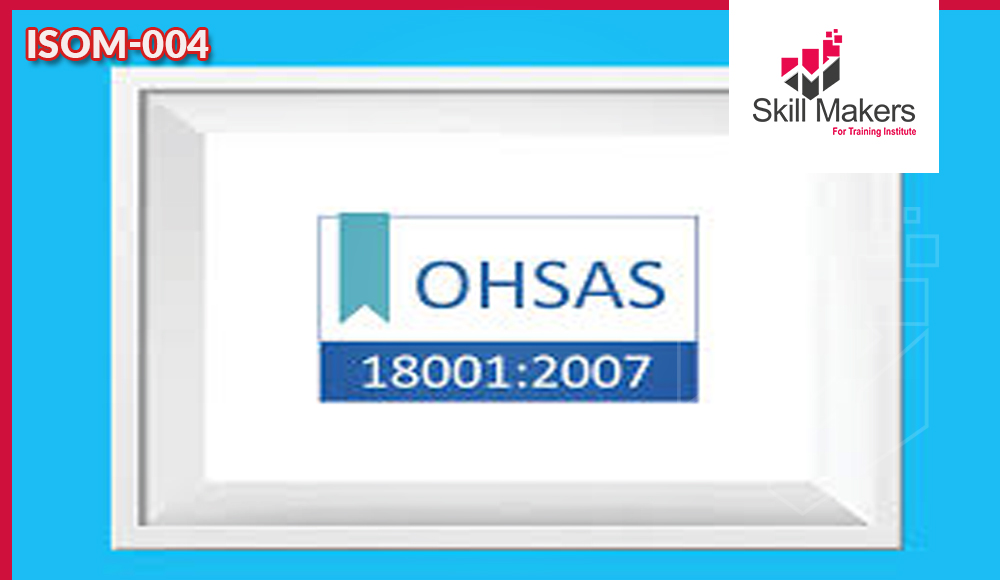-
Course Code
ISOM-004

Certified OHSAS 18001-2007 Lead Auditor
- This five-day OHSAS 18001:2007 Lead Auditor training course is CQI and IRCA Certified (Ref: 17225) and fulfils the CQI and IRCA training requirements for registration as a 3rd-party OHS management systems auditor. You learn to build on the skills of how to plan, structure and conduct an effective OHSAS 18001:2007 audit and to evaluate and communicate the findings. The course is designed to follow the stages in a live audit, including simulated audit interviews and role play closing meetings.
Learning Outcomes
- An understanding of the role of audits within the OH&S program
- Ability to develop an internal audit process to support your OH&S policy
- Enable participants, understand Key concepts in OHSMS auditing
- Impart and enhance practical auditing skills to become internationally recognized certified Auditor/Lead Auditor
- The ability to assess compliance of an organization to meet your own internal or external (e.g. Certification body) requirements
- Enable the participants to plan, conduct & manage OHSMS external (second and third party) as well as internal audits in accordance with the principles & guidance of ISO 19011
Course Contents
- About Safety Management Systems
- Role and benefits of ISO 18001
- Importance of ISO 18001 in an organization
- Models and principles
- Core fundamental concepts
- Understand key terms and definitions
- The need for Occupational Health and Safety
- Purpose, features, history and goals of ISO 18001
- Phases of ISO 18001
- Preparing for emergency and response
- OHSAS clauses
- Analyze the existing OHSMS in an organization
- Make and write plans for proper implementation of OHSMS
- Policies
- Associated Risks
- The scope of ISO 18001 in an organization
- Implementing policies
- Improving continuously by analyzing the present state
- The relationship between different components
- Reviewing performance and implementing controls
- Structure and elements of successful ISO 18001 implementation
- Risk assessment principles
- Requirements of organization
- Components of policies
- Staying up to date with latest approaches
- The audit tools and techniques
- Plan and prepare health and safety audits reports
- Using checklists
- Interview
- Evaluation
- Sampling
- Observation
- Conducting, writing and reporting audits
- Improvements by reviewing reports
- Implementation techniques
- Corrective and preventive actions
- Conduct meetings
- Identification and control of hazards
- Methods and techniques for controlling hazards
- Risk assessment and management
- Implementing the best suitable frameworks
- Make project plan and business cases
- About internal and external auditing
- Create and analyses reports made by other auditors
- Training and awareness programs for other members of the organization
- Enhancing communication with other auditors
- Implement security measures
- Handling emergency situations
- Understanding security models
- Prevent health hazards
- Evaluate performance
- Performance indicators
- Decision making in compliance with the OHSMS
- Frameworks in compliance to ISO 18001
- Proper documentation and test plans
- Conduct meetings with other members and auditors
- Manage incidents and reduce safety risks
- Implement controls in respective required areas
- Methods for monitoring and measuring performance
- Approaches for continuous improvement
- Preventive and corrective action
- Verification tools
- Feedback and exercises
- Regulations and legislation
- Health surveillance
- Frameworks
- Normative
- Regulatory
- Approaches to evidence and reports
- Enhancing communication
- Audit procedures
- Review reports and documents
- Verify reports
- Techniques for verifying reports
- Quality review
- Documentation
- Implementing correct action plans
- Audit management system
- ISO 18001 certification process
- Final Exam
Module 1: Occupational Health and Safety Management Systems
Module 2: Why Have an ISO 18001 System?
Module 3: Plan, Do, Check, Act Model
Module 4: Role and Responsibilities of an Internal Auditor
Module 5: Scope of OHSMS in an Organization
Module 6: Role and Responsibilities of a Lead Implementer
Module 7: Monitoring and Continuous Review
Module 8: Role and Responsibilities of a Lead Auditor
Module 9: Resolving Health and Safety Issues
Our Methodology
- Make coaching and monitoring innovative and using modern
- Media training also using on the go training by using interactive means and focusing on
- The exercises, practical applications and real situations study
- Live delivery method, instructor-led training
- Experienced consultant, trainers, and professional
- Qualified trainer with high-level experience
Attendance Reports
- Send daily attendance reports to training departments
- Send full attendance report to training dep. by the end of the course
- Attend 100 % from the course days also provide daily
- Issue attendance certificate for participant who attend minimum 80% from the course duration
Pre/Post Reports
- Pre- assessment before starting training
- Post assessment after finish training
- Full report for the deferent between Pre-& Post assessment
Who Should Attend
- Those responsible for obtaining certification to OHSAS 18001
- Those who wish to register as an IRCA OH&S MS auditor
- Auditors who want to audit OH&S management systems and who need to show professional competence in this subject
- Auditors wishing to understand OH&S MS auditing
- Senior managers involved in the outcome of OH&S audits
